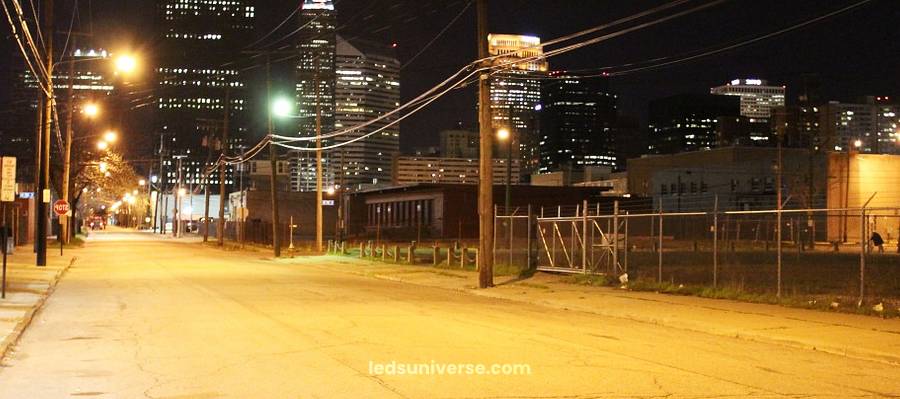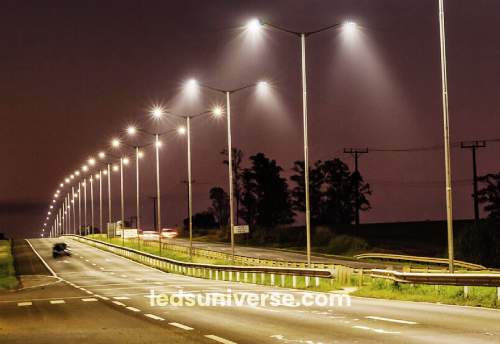In the quest for optimal street lighting, a range of factors must be evaluated, including the fixture’s energy consumption, lifespan, light quality, and adaptability to various environments. Modern advancements have introduced innovative solutions that cater to diverse needs—from the energy-saving prowess of LED lights to the eco-friendly benefits of solar-powered systems.
By enhancing safety and security, it contributes significantly to the overall well-being of a community. Properly designed and implemented street lighting systems ensure clear visibility for drivers and pedestrians alike, reducing the risk of accidents and improving navigation through city streets during nighttime.
Reach out for free lighting consultation
Table of Contents
ToggleSelecting the appropriate street lighting fixtures involves evaluating various factors to ensure optimal performance and longevity. Key considerations include energy efficiency, durability, and light quality. Modern street lighting fixtures incorporate advanced technologies and features designed to address diverse needs and environmental conditions. This section explores the leading types of street lighting fixtures and their advantages.
One of the widely adopted options in contemporary street lighting is LED (Light Emitting Diode) technology. LEDs have revolutionized street lighting due to their impressive energy efficiency and long operational life.

LED street lights are renowned for their low energy consumption. Compared to traditional lighting sources like incandescent or high-pressure sodium lamps, LEDs use significantly less power to produce the same amount of light. This efficiency translates to lower energy bills and a reduced carbon footprint, making LEDs an environmentally friendly choice.
Another advantage of LED fixtures is their extended lifespan. LEDs can last up to 100,000 hours or more, which is several times longer than conventional lamps. This longevity reduces the frequency of bulb replacements, thus lowering maintenance costs and minimizing disruptions caused by maintenance activities.
LEDs offer high-quality light with excellent color rendering, which enhances visibility and safety. They are available in various color temperatures, from warm white to cool white, allowing for customization based on specific lighting requirements. For urban streets, a cooler color temperature (around 4000K) is often preferred to replicate daylight and improve visibility.
High-Pressure Sodium lamps have been a staple in street lighting for decades. While they are being gradually replaced by LEDs, they still offer certain benefits that make them suitable for specific applications.
HPS lamps are generally more cost-effective upfront compared to LEDs. Their initial purchase and installation costs are lower, which can be advantageous for budget-constrained projects. However, the long-term savings associated with LED technology, such as reduced energy and maintenance costs, often outweigh the initial cost benefits of HPS lamps.
HPS lamps produce a high level of luminous output and have a long service life, though not as extended as LEDs. Their yellow-orange light provides good penetration through fog and rain, making them suitable for certain outdoor environments. However, their color rendering is poor compared to LEDs, which can affect visibility and safety.
Metal Halide lamps are another option for street lighting, known for their superior color rendering and bright light.
Metal Halide lamps produce a bright, white light that closely mimics natural daylight. This quality is particularly valuable in areas requiring accurate color differentiation, such as commercial districts or high-traffic intersections. Their high color rendering index (CRI) makes them a good choice for enhancing visual clarity.
Despite their advantages in light quality, Metal Halide lamps have a shorter lifespan and lower energy efficiency compared to LEDs. They require more frequent replacements and consume more power, which can lead to higher operational costs. Additionally, their performance can be affected by temperature fluctuations, making them less suitable for extreme climates.
Solar-powered street lights are an innovative solution that harnesses solar energy to power LED fixtures, combining sustainability with advanced technology.
Solar-powered street lights offer environmental benefits by reducing reliance on grid electricity. They operate using energy collected from sunlight, which helps lower greenhouse gas emissions and conserves non-renewable resources. This eco-friendly approach is particularly suitable for off-grid locations or areas with abundant sunshine.
One of the advantages of solar-powered lights is their independence from the electrical grid. This feature eliminates the need for extensive wiring and reduces installation costs. Additionally, since solar lights do not require electricity from the grid, they provide long-term cost savings and are less susceptible to power outages.
The integration of smart technologies into street lighting systems is transforming urban landscapes, offering enhanced functionality and efficiency.

Adaptive lighting systems use sensors and controllers to adjust light levels based on real-time data, such as traffic volume or ambient light conditions. This capability allows for dynamic changes in illumination, optimizing energy use and enhancing safety during peak and off-peak hours.
Smart street lighting systems often include remote monitoring and control features, enabling operators to manage and troubleshoot lighting fixtures from a central location. This functionality facilitates timely maintenance, reduces operational costs, and ensures that the lighting system remains in optimal condition.
Among the most popular choices for street lighting are LED (Light Emitting Diode) fixtures. LEDs have become a preferred option due to their energy efficiency and long lifespan. They consume significantly less power compared to traditional incandescent or halogen lamps, leading to reduced energy costs.
LED street lights provide bright, clear illumination with minimal light pollution. They are available in various color temperatures, allowing for customization based on specific lighting requirements and preferences. For instance, a cool white light (around 4000K) is often used for urban streets to mimic daylight and enhance visibility.
High-Pressure Sodium lamps have been a traditional choice for street lighting. They are known for their high luminous efficacy and long life, though they are gradually being replaced by LED technology. HPS lamps emit a distinctive yellow-orange light, which is less favored in modern street lighting due to its poor color rendering. Despite this, they are still used in areas where initial cost is a significant concern.
Metal Halide lamps offer better color rendering than HPS lamps and provide a more natural light. They are often used in areas requiring high-quality illumination, such as sports facilities and high-traffic intersections. However, Metal Halide lamps have a shorter lifespan compared to LEDs and are less energy-efficient.
Designing an effective street lighting system involves several considerations to ensure optimal performance and safety.
The primary goal of street lighting is to provide adequate illumination to enhance visibility and safety. Optimal lighting levels vary depending on the type of road, traffic volume, and surrounding environment. For instance, residential streets generally require lower lighting levels compared to major highways or commercial areas.
Lighting levels are typically measured in lux, which represents the amount of light falling on a surface. For residential streets, a minimum of 5 to 10 lux is often recommended, while main roads and intersections might require 20 to 30 lux or more. The lighting design should ensure uniformity to avoid dark spots and excessive brightness, which can cause discomfort for drivers and pedestrians.
Uniformity is crucial in street lighting design to provide consistent illumination across the road surface. Proper lighting distribution helps in reducing shadows and minimizing glare, which can impair visibility. Street lighting fixtures should be positioned to achieve even light distribution, avoiding areas of excessive brightness or darkness.
The spacing of street lights is another factor that impacts lighting uniformity. Fixtures should be placed at appropriate distances to ensure that overlapping light patterns provide consistent coverage. The use of advanced lighting controls and dimming features can also enhance uniformity and adjust illumination based on real-time needs.
Light pollution is a growing concern in urban areas, as excessive or poorly directed light can disrupt the natural night environment and impact human health. Effective street lighting design should incorporate measures to control light pollution and reduce glare.
Shielded fixtures and proper aiming can minimize the amount of light that spills beyond the intended area. Full cutoff fixtures, which direct light downward, are particularly effective in reducing light trespass and skyglow. Additionally, using lower color temperature lights can help reduce glare and improve visual comfort.
Proper installation and maintenance ensure the longevity and effectiveness of street lighting systems.
Street lighting fixtures should be installed at appropriate heights and angles to achieve the desired illumination levels and distribution. The installation process should comply with local regulations and standards to ensure safety and performance. Proper wiring and electrical connections are crucial to prevent issues such as power outages or short circuits.
Routine inspections should be conducted to check for issues such as malfunctioning lights, damaged fixtures, or accumulated debris. Timely replacement of faulty components and cleaning of fixtures can extend the lifespan and efficiency of the lighting system.
The adoption of smart lighting technologies, such as remote monitoring and control systems, can simplify maintenance tasks. These systems allow for real-time monitoring of light performance and automatic adjustments based on traffic patterns or environmental conditions.
The field of street lighting is continuously evolving with advancements in technology and design. Some of the key trends shaping the future of street lighting include:
Smart street lighting systems integrate sensors, controllers, and communication technologies to optimize lighting performance. These systems can adjust light levels based on real-time data, such as traffic flow or weather conditions. Smart lighting enhances energy efficiency, reduces operational costs, and improves overall safety.
Solar-powered street lights are gaining popularity due to their sustainability and independence from the grid. These fixtures use solar panels to harness sunlight and convert it into electricity, powering LED lights. Solar-powered street lights are particularly suitable for remote or off-grid locations.
Adaptive lighting solutions use advanced technologies to automatically adjust illumination based on environmental factors. For example, adaptive lighting systems can dim or brighten street lights in response to traffic volume, pedestrian activity, or weather conditions. This dynamic approach enhances energy efficiency and provides better lighting conditions when needed.
By selecting the right fixtures, considering design factors, and implementing best practices for installation and maintenance, cities can enhance visibility, reduce crime, and improve the overall quality of life for residents. As technology continues to advance, the future of street lighting holds exciting possibilities for smarter, more sustainable, and adaptable solutions.